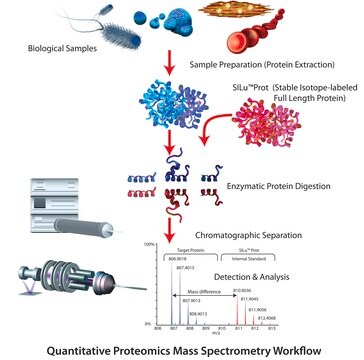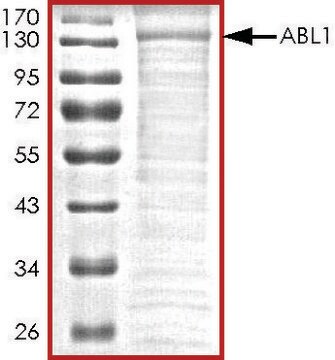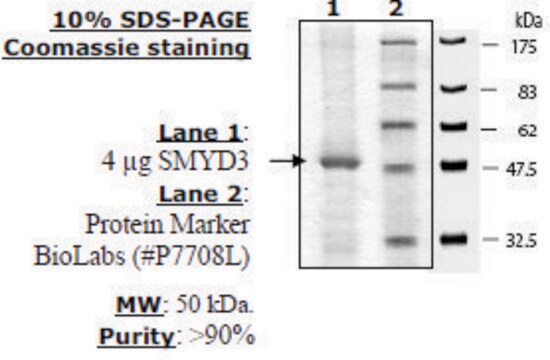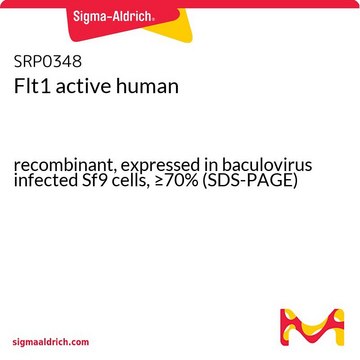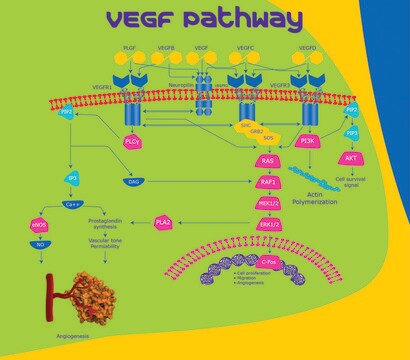PF082
VEGFR1, ludzki, rekombinowany, S. frugiperda
Synonim(y):
Receptor czynnika wzrostu śródbłonka naczyniowego-1, Flt-1, EMRK2
Zaloguj sięWyświetlanie cen organizacyjnych i kontraktowych
About This Item
Kod UNSPSC:
12352202
NACRES:
NA.77
Polecane produkty
Próba
≥90% (SDS-PAGE)
Poziom jakości
Formularz
lyophilized
producent / nazwa handlowa
Calbiochem®
warunki przechowywania
OK to freeze
zanieczyszczenia
≤1 EU/μg Endotoxin (EU/μg cytokine)
Warunki transportu
wet ice
temp. przechowywania
−20°C
Opis ogólny
Rekombinowane ludzkie białko VEGFR-1 wyrażane w komórkach owadów S. frugiperda. Związane disiarczkiem dimeryczne białko rekombinowane zawiera dwa polipeptydy o długości 905 aminokwasów i przewidywanej monomerycznej masie cząsteczkowej ~100 kDa. W wyniku glikozylacji monomer migruje jako białko ~123 kDa w SDS-PAGE. Czynnik wzrostu śródbłonka naczyniowego (VEGF), znany również jako czynnik przepuszczalności naczyń (VPF), jest wydzielaną cytokiną wiążącą heparynę, ulegającą ekspresji w komórkach nowotworowych i zwierzęcych. VEGF jest powiązany z kontrolą angiogenezy ze względu na jego selektywną mitogenną stymulację komórek śródbłonka naczyniowego i zwiększenie przepuszczalności naczyń. VEGF jest dimerem ~34-50 kDa dwóch identycznych podjednostek połączonych disiarczkiem, istniejących w czterech gatunkach molekularnych; 121, 165, 189 i 206 reszt aminokwasowych, powstających w wyniku alternatywnego splicingu pojedynczego genu. VEGF wiąże się z dwiema receptorowymi kinazami tyrozynowymi, Flt-1 (VEGFR1) i KDR/Flk-1 (VEGFR2), występującymi prawie wyłącznie na ludzkich komórkach śródbłonka. Flt-1 wiąże VEGF i nowy ligand związany z VEGF, łożyskowy czynnik wzrostu (PIGF), ale KDR/Flk-1 wiąże tylko VEGF. CDNA kodujące rozpuszczalną, skróconą formę Flt-1 sklonowaną z biblioteki ludzkich komórek śródbłonka koduje 6 N-końcową, podobną do IgG zewnątrzkomórkową domenę wiążącą ligand, ale nie koduje regionu obejmującego błonę i wewnątrzkomórkowych domen kinazy tyrozynowej. Rekombinowany rozpuszczalny receptor silnie wiąże się z VEGF i jest silnym antagonistą VEGF. Niedawno zidentyfikowano trzeci receptor VEGF i sklonowano go z komórek nowotworowych. Ten receptor VEGF jest specyficzny dla izoformy, wiążąc VEGF165, ale nie VEGF121. Badania wskazują, że ten receptor VEGF (VEGF165R) jest identyczny z ludzką neuropiliną-1, receptorem dla rodziny kolapsyn/semaforyn, który pośredniczy w prowadzeniu komórek neuronalnych.
Działania biochem./fizjol.
EC₅₀ 15-30 ng/ml w teście proliferacji komórek z użyciem ludzkich komórek śródbłonka żyły pępowinowej
Ostrzeżenie
Toksyczność: Standardowa obsługa (A)
Postać fizyczna
Liofilizowany ze sterylnie filtrowanego PBS, 300 mM NaCl, 50 µg BSA/µg cytokiny.
Rekonstytucja
Odtworzyć do ≥10 µg/ml za pomocą sterylnego PBS zawierającego ≥0,1% HSA lub BSA. Zaleca się miareczkowanie białka w celu uzyskania optymalnych wyników w poszczególnych systemach.
Po rekonstytucji, podzielić i zamrozić (-20°C). Roztwory podstawowe są stabilne przez okres do 3 miesięcy w temperaturze -20°C.
Inne uwagi
Huang, K., et al. 2001. Int. J. Cell Biol.33, 315.
Soker, S., et al. 1998. Cell92, 735.
Kroll, J. and Waltenberger, J. 1997. J. Biol. Chem. 272, 32521.
Kendall, R.L. i Thomas, K.A. 1993. PNAS.90, 10705.
Klagsbrun, M. and Soker, S. 1993. Current Biology 3, 699.
Senger, D., et al. 1993. Cancer and Metastasis Rev.12, 303.
Brown, L., et al. 1992. Kidney International42, 1457.
Conn, G., et al. 1990. PNAS87, 1323.
Shibuya, M., et al. 1990. Oncogene5, 519.
Soker, S., et al. 1998. Cell92, 735.
Kroll, J. and Waltenberger, J. 1997. J. Biol. Chem. 272, 32521.
Kendall, R.L. i Thomas, K.A. 1993. PNAS.90, 10705.
Klagsbrun, M. and Soker, S. 1993. Current Biology 3, 699.
Senger, D., et al. 1993. Cancer and Metastasis Rev.12, 303.
Brown, L., et al. 1992. Kidney International42, 1457.
Conn, G., et al. 1990. PNAS87, 1323.
Shibuya, M., et al. 1990. Oncogene5, 519.
Informacje prawne
CALBIOCHEM is a registered trademark of Merck KGaA, Darmstadt, Germany
Ta strona może zawierać tekst przetłumaczony maszynowo.
Kod klasy składowania
11 - Combustible Solids
Klasa zagrożenia wodnego (WGK)
WGK 1
Temperatura zapłonu (°F)
Not applicable
Temperatura zapłonu (°C)
Not applicable
Certyfikaty analizy (CoA)
Poszukaj Certyfikaty analizy (CoA), wpisując numer partii/serii produktów. Numery serii i partii można znaleźć na etykiecie produktu po słowach „seria” lub „partia”.
Masz już ten produkt?
Dokumenty związane z niedawno zakupionymi produktami zostały zamieszczone w Bibliotece dokumentów.
Nasz zespół naukowców ma doświadczenie we wszystkich obszarach badań, w tym w naukach przyrodniczych, materiałoznawstwie, syntezie chemicznej, chromatografii, analityce i wielu innych dziedzinach.
Skontaktuj się z zespołem ds. pomocy technicznej
